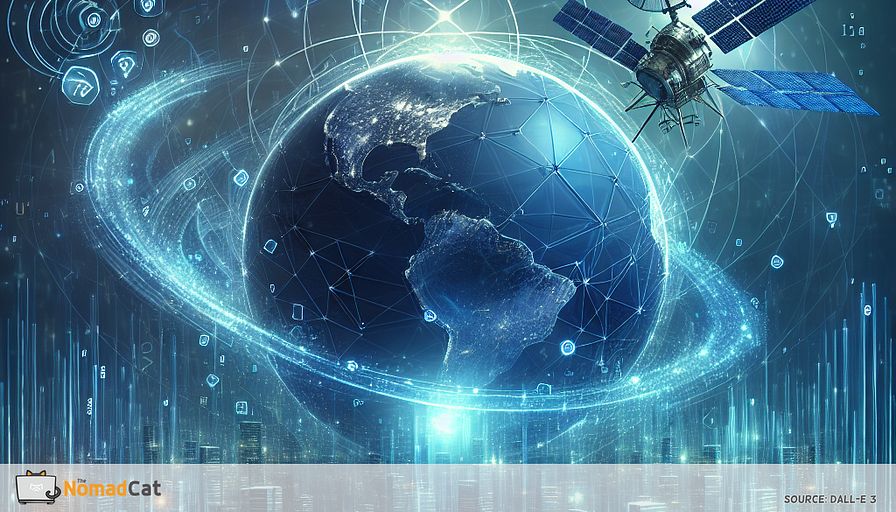Abstract:
The article discusses the growing importance of satellite communications for secure data transmission, particularly for startups aiming to enhance their data security while complying with regulations like GDPR. Satellite technology offers global coverage and advanced encryption methods, distinguishing it from traditional terrestrial networks. Key security features include frequency hopping, robust encryption, and controlled environments for secure data pathways, which together provide superior data protection and minimize risks from local disruptions. The article emphasizes the strategic integration of satellite technology to improve security, highlighting the benefits of decentralization, partnerships with satellite service providers for expertise and cost-sharing, and adherence to data protection regulations. Successful case studies illustrate the importance of strategic partnerships and regulatory compliance in deploying satellite solutions. Looking forward, advancements in Low Earth Orbit satellites, encryption, AI, and machine learning are expected to further enhance satellite security, while ethical considerations in data transmission will shape future regulatory landscapes. Overall, satellite communications are positioned as a vital solution for secure global communication, offering businesses a way to overcome vulnerabilities and maintain secure operations through strategic integration and regulatory alignment.
Satellite communications are becoming increasingly important for secure data transmission. They offer global coverage and advanced encryption methods, making them a strong option for secure communications. This piece explores the benefits of satellite technology for startups looking to enhance their data security while navigating regulations. Whether safeguarding critical information or meeting data protection rules, satellite technology plays a vital role in improving security.
Understanding the security benefits of satellite communications
Satellite communications provide security features that go beyond traditional methods. With cutting-edge encryption and safe data transmission, satellites offer unmatched data protection, making them essential in today's world.
Inherent security advantages
Satellite networks have security features that distinguish them from terrestrial networks.
Global Coverage and Risk Reduction
Satellites cover nearly the entire globe, offering a clear advantage over land-based systems. Unlike networks that depend on physical infrastructure, satellites are not affected by local disruptions like natural disasters. This global reach minimizes geographical risks, ensuring reliable communication.
Technological Resilience through Frequency Hopping
Frequency hopping is a key technology in satellite communications. It rapidly changes frequencies during transmission, making it tough for unauthorized parties to intercept signals. This method, along with other technologies, makes satellite communications more resistant to interference and jamming.
Robust Encryption for Superior Data Protection
Encryption is crucial in satellite communications. Compared to terrestrial networks, satellites often use more advanced encryption protocols, keeping data safe from unauthorized access. The controlled settings of satellite uplinks and downlinks enhance these encryption measures, offering an extra layer of protection.
Types of Satellites and Their Functions
Understanding the different types of satellites is crucial for grasping their role in secure communications.
Geostationary Earth Orbit (GEO)
GEO satellites remain fixed relative to a point on Earth, providing consistent coverage for specific regions. Their stable position makes them ideal for broadcasting and weather monitoring.
Medium Earth Orbit (MEO)
MEO satellites orbit at a moderate distance, offering a balance between coverage and latency. They are often used for navigation systems like GPS.
Low Earth Orbit (LEO)
LEO satellites orbit closer to Earth, providing low latency and high bandwidth. They are increasingly used for internet services and are pivotal in enhancing security capabilities due to their proximity.
Encryption and secure data transmission
Encryption is essential for keeping data secure during satellite transmissions.
Ensuring Data Integrity and Confidentiality through Advanced Encryption
Advanced encryption in satellite communications keeps data intact and private during transmission, which is crucial given the long distances data travels. By using top-tier encryption, satellite networks maintain the highest data protection standards.
Controlled Environments Reinforce Security Protocols
Satellite uplinks and downlinks provide a controlled environment, boosting encryption efforts. This setup protects against data breaches, ensuring secure data transmission.
Secure Transmission Protocols Prevent Data Interception
Secure protocols are key in preventing data interception during satellite communications. They protect data through its journey, maintaining its confidentiality and integrity.
Integration strategies for enhanced security
Integrating satellite communications can greatly enhance a startup’s data security. This requires strategic planning to ensure smooth integration.
Infrastructure integration
Startups should assess their current infrastructure to find the best integration points for satellite technology. Steps include:
- Evaluating existing systems: Determine which can benefit from satellite integration.
- Securing data pathways: Focus on safe transmission routes for sensitive data.
- Analyzing vulnerabilities: Identify areas where satellite services can reduce risks.
Decentralizing data transmission by spreading it across multiple nodes can prevent data breaches and improve network resilience.
Reflecting on my experience as a startup founder, I found that partnerships with satellite service providers were invaluable. They offer:
- Technical support: Insights from experienced providers.
- Cost-sharing opportunities: Shared resources to manage expenses.
- Access to advanced features: Without heavy upfront investments.
Best practices for end-to-end encryption
Comprehensive encryption is crucial when using satellite services. Multi-layer encryption strategies safeguard data throughout its journey.
- Implement industry-standard protocols: Like AES or RSA for strong security.
- Routine updates: Keep encryption measures effective against new threats.
Regular audits ensure compliance with evolving security standards, strengthening security and building client trust.
Navigating European data protection regulations
European data protection regulations can be challenging, but satellite communications can help startups meet these demands.
GDPR compliance with satellite communications
Enhanced encryption aligns with GDPR data protection requirements
Satellite technology helps startups meet GDPR requirements with its advanced encryption, ensuring data protection during transmission. Geo-fencing further supports compliance by controlling where data can travel.
Geo-fencing capabilities help maintain data sovereignty
Geo-fencing restricts data travel, ensuring it stays within specific areas, thus supporting GDPR rules. This allows businesses to focus on operations without worrying about compliance.
Real-time monitoring supports GDPR's data processing principles
Satellite technology provides real-time monitoring, essential for GDPR compliance. It tracks data flows and ensures they align with GDPR principles, aiding in immediate response to unauthorized access.
Legal considerations for satellite data transmission
Transmitting data via satellite involves understanding GDPR and other EU frameworks.
Understanding GDPR's requirements for lawful data processing and cross-border transfers via satellite
Compliance with GDPR's guidelines on data processing and transfers is crucial. Mechanisms like SCCs or BCRs provide adequate protection.
Compliance with radio spectrum management and licensing regulations is necessary
Startups must adhere to radio spectrum and licensing regulations to operate legally and efficiently, ensuring a sturdy communication framework.
Implement technical and organizational security measures according to GDPR's Article 32
Article 32 requires robust security measures. For satellite communications, this means deploying advanced encryption and secure protocols, ensuring data protection and compliance.
Successful implementations and strategies
Satellite communications have helped startups improve security and connectivity. By focusing on partnerships and compliance, they have effectively integrated satellite technology.
Strategic partnerships for satellite integration
- A startup enhanced data security in remote areas using satellite communications, ensuring seamless data transmission where terrestrial infrastructure was lacking.
- Partnerships with satellite providers gave them access to technology and expertise, showing the importance of collaboration in deploying satellite solutions.
Regulatory compliance for secure operations
- Startups have tackled regulatory challenges by implementing compliance tactics.
- Understanding GDPR requirements and using mechanisms like SCCs and BCRs have been key to legal and secure satellite operations.
- Adhering to spectrum and licensing rules has also ensured a solid operational framework.
Lessons learned and takeaways
Startups’ experiences highlight the importance of decentralization, collaboration, regulatory planning, and adaptability.
Key strategies for successful integration
- Decentralization and collaboration: Reduces single points of failure, enhancing resilience. Partnerships provide support and cost efficiency.
- Regulatory compliance in planning: Proactive planning avoids legal issues, safeguarding operations.
Reflecting on my journey, I realized the critical role adaptability plays. Embracing new satellite technologies keeps startups competitive, enhancing their security frameworks.
Future trends in satellite security
Satellite security is evolving with new technologies that promise better data protection.
Emerging technologies in satellite security
Low Earth Orbit (LEO) satellites, which offer lower latency and higher bandwidth, are enhancing security capabilities. Advances in encryption also play a critical role, ensuring data remains secure. AI and machine learning are becoming key to predictive security measures, providing a proactive defense.
Predictions for the satellite security landscape
There will be increased reliance on satellite communications for secure data transmission, especially in areas with limited connectivity. Future regulatory developments will focus on ethical satellite surveillance, requiring organizations to adapt to maintain compliance.
Satellite communications are crucial for securing digital interactions, offering global reach and strong encryption. By integrating satellite technology, businesses can overcome traditional network vulnerabilities, ensuring secure communication. Strategic partnerships and regulatory compliance highlight the practicality of satellite innovations. Embracing these technologies is vital for maintaining secure operations in the future.














